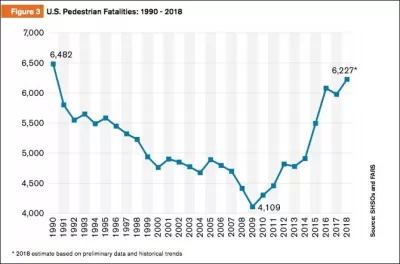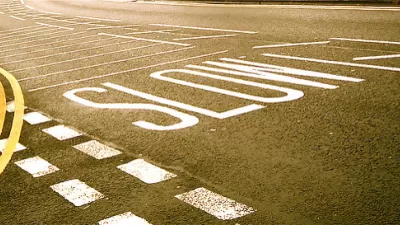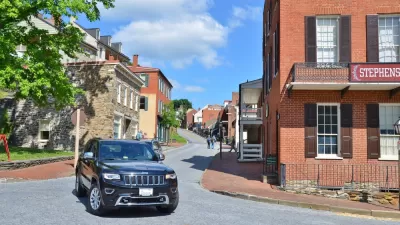Europe proves to Americans that when it comes to pedestrian fatalities, it doesn't have to be this way.

Joe Cortright takes a deep dive into the latest traffic safety data provided by the National Highway Traffic Safety Administration.
The most alarming data from the latest traffic safety report, as summarized by Cortright, "In the nine years from 2009 and 2018, pedestrian deaths increaseed 51 percent from 4,109 to 6,227."
Cortright's larger point isn't to prove exactly why so many more cars are killing so many more pedestrians on streets and roads around the country, but that Americans should not accept these tragedies as a necessary result of mobility. Americans only need look to Europe, which has greatly reduced pedestrian fatalities over the same span.
While some may regard a pedestrian death toll as somehow unavoidable, the recent experience of European countries as a group suggests that there’s nothing about modern life (Europeans have high rates of car ownership and as many smart phones as Americans) that means the pedestrian death toll must be high and rising. In fact, at the same time pedestrian deaths have been soaring the US, they’ve been dropping steadily in Europe. In the latest nine year period for which European data are available, pedestrian deaths decreased from 8,342 to 5,320, a decline of 36 percent.
Those data come from the European Road Safety Observatory [pdf].
Aaron Short at Streetsblog USA first reported on the pedestrian safety data from the NHTSA.
FULL STORY: Why are US drivers killing so many pedestrians?

Trump Administration Could Effectively End Housing Voucher Program
Federal officials are eyeing major cuts to the Section 8 program that helps millions of low-income households pay rent.

Planetizen Federal Action Tracker
A weekly monitor of how Trump’s orders and actions are impacting planners and planning in America.

The 120 Year Old Tiny Home Villages That Sheltered San Francisco’s Earthquake Refugees
More than a century ago, San Francisco mobilized to house thousands of residents displaced by the 1906 earthquake. Could their strategy offer a model for the present?

HSR Reaches Key Settlement in Northern California City
The state’s high-speed rail authority reached an agreement with Millbrae, a key city on the train’s proposed route to San Francisco.

Washington State Legislature Passes Parking Reform Bill
A bill that would limit parking requirements for new developments is headed to the governor’s desk.

Missouri Law Would Ban Protections for Housing Voucher Users
A state law seeks to overturn source-of-income discrimination bans passed by several Missouri cities.
Urban Design for Planners 1: Software Tools
This six-course series explores essential urban design concepts using open source software and equips planners with the tools they need to participate fully in the urban design process.
Planning for Universal Design
Learn the tools for implementing Universal Design in planning regulations.
Ada County Highway District
Clanton & Associates, Inc.
Jessamine County Fiscal Court
Institute for Housing and Urban Development Studies (IHS)
City of Grandview
Harvard GSD Executive Education
Toledo-Lucas County Plan Commissions
Salt Lake City
NYU Wagner Graduate School of Public Service





























